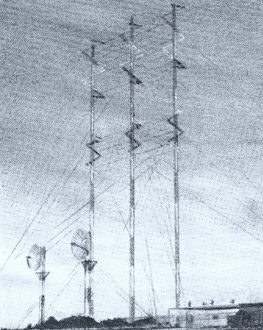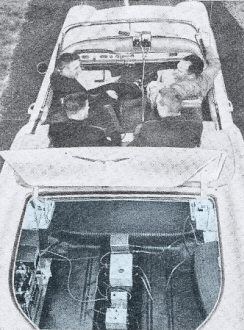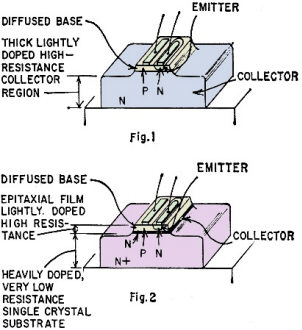News Briefs |
|
Long distance communications via satellite were a few years off when Pacific Scatter Communications System (PSCS) was established as a network of microwave radio relays that spanned the Pacific Ocean during the Cold War era. It was established by the U.S. in the late 1950s as a means of maintaining secure communications with its military and diplomatic installations in Asia, particularly in Japan and South Korea. PSCS consisted of a series of shortwave and microwave relay stations located on islands throughout the Pacific, including Hawaii, Guam, Saipan, Okinawa, and, as reported in this 1960 issue of Radio−Electronics magazine, Wake Island. The system was designed to be highly resilient, with redundant communication paths and backup power supplies to ensure that communication could be maintained even in the event of a nuclear attack. It played a critical role in supporting military operations during the Vietnam War and in maintaining diplomatic relations with allies in Asia. The PSCS was eventually superseded by more advanced satellite communication systems in the 1980s. Also in the news, General Motors was experimenting with self-driving cars, a concept that more than six decades later, is still not implemented in everyday life. Hotels were working hard to get TVs in every room, being at 81% penetration as of 1960. New Briefs: 11/1957 | 8/1958 | 11/1959 | 2/1960 | 4/1960 | 8/1960 | 3/1961 | 5/1961 | 6/1961 | 12/1961 | 3/1963 | 4/1963 | 8/1963 | 9/1963 | 8/1964 | 12/1964 | 1/1967 | 3/1967 | 4/1967 | 9/1967 | 4/1968 News Briefs
A 6500-mile communications system designed to give the Pacific area virtually trouble-free communications has gone into operation. Built for use by the Armed Forces, the Pacific Scatter Communications System uses advanced ionospheric and tropospheric scatter propagation to give better than 99% reliability. Unlike most scatter systems, parabolic antennas are not used. Instead, 200- and 400-foot antenna arrays composed of stacked dual-frequency corner reflectors handle the signals rather than the more usual dishes. The ones shown in the photo are at the Wake Island station. The scatter technique beams radio signals at the ionosphere or the troposphere, to bounce back to earth in a scattered fashion. The signals are not broken up. They are only scattered. Diversity reception is used. One receiver will pick up the clearest signal. If it should fade, another receiver will pick up another "branch" of the same signal without a lapse. In this way a steady flow of intelligible trouble-free information is insured. The system, which was built by the Army and Page Communications Engineers, permits reliable communications between a transmitter and receiver 600 to 1,200 miles apart, even under conditions which disrupt normal long-distance radio signals.
A full-size electronic highway has had its first public showing. Demonstrated by RCA in cooperation with General Motors, two specially equipped cars were guided automatically around a test track at RCA's David Sarnoff Research Center in Princeton, N. J. Acceleration, braking and maintaining a safe distance between vehicles were all automatically controlled by electronic signals from the road. (Radio-Electronics described this system in an article by Vladimir K. Zworykin, "Electronics Guides Your Car". This story in the April, 1959, issue was one of a series on electronic highways.) During the tests, circuits built into the road were used to inform the cars' "drivers" of simulated road intersections, service areas or hazardous conditions ahead. This automatic electronic road can be used by electronically equipped and by non-equipped autos simultaneously. Both produce warning signals. The difference is that the equipped car uses its complement of electronic gear (see photo) to automatically react to electronic signals. The driver of the standard car must keep track of roadside signs and lights that warn him of cars head and other possible dangers. A new production technique makes it possible to build switching transistors that work 10 times faster than existing ones. Units made by the new process are called epitaxial diffused transistors. This process forms an extremely thin, lightly doped collector region which is grown on a heavily doped low-resistance layer. The lightly doped area has a high resistance and, by keeping this layer thin, collector resistance is reduced and switching time with it. Epitaxial diffusion makes possible a high-resistance collector layer that is as much as 30 times as thin as usual. The epitaxial techniques, developed by Bell Telephone Laboratories, can be added to existing diffused-base transistor production lines with little trouble. The process is simple. Single crystal wafers of heavily doped material are cut and polished. Then a thin film (about 0.1 mil) of a lightly doped material is deposited on the wafer to provide the desired collector region. From this point on, standard diffused base techniques are used. The diagrams show the difference in the construction of standard (Fig. 1) and epitaxial (Fig. 2) switching transistors. Transparent Semiconductor Methods of growing single crystals of gallium phosphide, a transparent semiconductor material, are being developed at Bell Telephone Laboratories. The properties of this substance are also being investigated. Since the material is transparent, it is possible to observe visually the differences which take place under varying conditions of doping and electron density. The largest single crystals produced so far measure 3/4 inch long by 1/4 inch square. The experimental work is aimed at a general understanding of semiconductors and junctions. Motels Like TV A nation-wide survey of TV sets, antennas and service revealed that 15,660 out of 19,337 motel rooms have TV sets, according to American Motel Magazine. Most of those who do not have sets installed plan to get them within the next year. Motel owners indicated that the greatest problem related to room TV installations is not reception or servicing, but instead is the misuse, mishandling and tampering with sets by guests. They rated sturdiness as one of the lesser problems along with theft and antenna trouble. The owners also showed a marked preference for master antenna systems over indoor antennas and individual room systems. Piezoelectric Compounds The discovery of two strong new piezoelectric compounds - zinc oxide and cadmium sulfide - has been reported by Dr. A. R. Hutson of Bell Telephone Laboratories. The degree of piezoelectricity of zinc oxide is about four times as great as that of quartz while that of cadmium sulfide is about twice as great. Both zinc oxide (ZnO) and cadmium sulfide (CdS) are n-type semiconductors with the ZnO having a room temperature resistivity of less than 10^3 ohm−cm. This relatively low resistivity effectively shorts out all experimental evidence of piezoelectricity unless the ZnO is first doped with an impurity (lithium) that accepts the excess electrons (which contribute to the conductivity). After doping, the resistivity of the ZnO was raised to 10^12 ohm−cm.
Posted March 15, 2023 |
|




